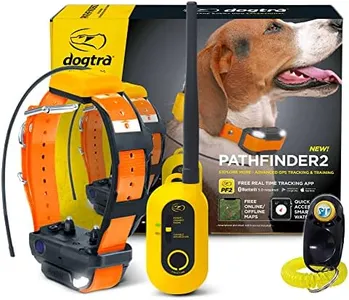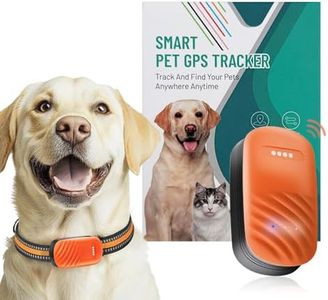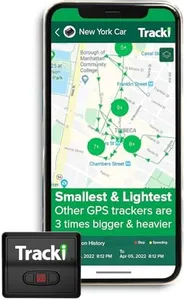We Use CookiesWe use cookies to enhance the security, performance,
functionality and for analytical and promotional activities. By continuing to browse this site you
are agreeing to our privacy policy
10 Best Gps Dog Trackers
From leading brands and best sellers available on the web.Buying Guide for the Best Gps Dog Trackers
Choosing a GPS dog tracker can greatly improve the safety and well-being of your pet. A GPS tracker allows you to monitor your dog's location in real time, providing peace of mind and quicker responses if your dog ever wanders off. When picking the right tracker, you'll want to think about your dog's typical environment, activity level, and your personal preferences for features. Understanding the main specifications can help you focus on what's most valuable for your lifestyle and your dog’s needs.Tracking RangeTracking range tells you how far away the tracker can accurately report your dog's position from your smartphone or computer. This is important because a longer range allows you to find your dog more easily if they venture far, while short ranges might limit performance to just your backyard. Products generally fall into three segments: Bluetooth/short distance trackers which work up to a few hundred feet, radio frequency trackers which may reach up to a couple of miles, and GPS/cellular trackers that can work anywhere there is cellular coverage. If your dog rarely leaves your immediately surroundings, a short-range tracker could work. If your dog likes to explore, runs off-leash, or if you frequent large parks, favor a GPS tracker with nationwide or even global coverage.
Battery LifeBattery life refers to how long the device can operate before needing a recharge. This matters because a longer battery life reduces the chance of the tracker dying while your dog is out and about. Typically, trackers offer anything from a day or two up to several weeks on a single charge. Light, low-feature trackers tend to last longer, while those with real-time updates and a lot of functions may need more frequent charging. If you want minimal maintenance and infrequent charging, look for models advertised for extended battery life. However, if you don’t mind charging every few days and want constant, real-time tracking, this may be less critical.
Size and WeightThe size and weight of the tracker determine how comfortable it will be for your dog to wear. A heavy or bulky device might bother smaller or sensitive dogs, while larger breeds may be unphased by a heavier tracker. Some trackers are as light as a few grams and ideal for small dogs or puppies, while others are made for sturdier, larger dogs. Always think about your dog’s breed and size—ensure the tracker is light and streamlined enough that your dog can wear it comfortably at all times.
Water ResistanceWater resistance describes the device's ability to withstand moisture, which is crucial if your dog swims, plays in the rain, or enjoys muddy adventures. Trackers are often rated either splash-proof, water-resistant, or fully waterproof. For dogs that may only experience light rain or morning dew, a splash-proof model should suffice. If your dog is often around water (lakes, pools, etc.), opt for a fully waterproof tracker to avoid malfunctions or damage.
Update FrequencyUpdate frequency means how often the tracker sends your dog’s location to you. Higher update frequencies provide near real-time tracking, but can use more battery. Lower frequencies save battery but may not show your dog’s latest position. Trackers can range from updating every few seconds to only every few minutes. If your priority is pinpoint tracking (for example, with high-activity, escape-prone dogs), favor devices that update as frequently as possible. For general peace of mind with a usually well-behaved pet, slower updates are often sufficient.
Subscription RequirementMany GPS dog trackers require a monthly or yearly subscription fee, especially if they use cellular networks. This fee typically covers the cost of data used when sending location information. Some trackers operate on radio frequencies or Bluetooth and do not require subscriptions, but may have more limited range. Consider how comfortable you are with ongoing costs versus the features and coverage provided—if you travel often or want reliable nationwide service, a subscription-based tracker may be the most suitable.
DurabilityDurability includes both how well the device withstands rough play and exposure to the elements. Dogs can be tough on collars and devices—they roll, dig, and run through thick brush. A robust, rugged design can prevent breakage, especially if your dog is active or outdoors a lot. Pay attention to trackers made with strong, shatter-resistant materials for higher durability. If your dog is gentle and stays mostly indoors or on-leash, a less rugged device may still last a long time.










